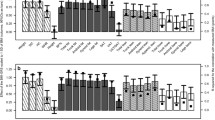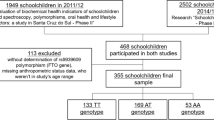Abstract
Background: Genome-wide association studies on body mass index (BMI) have identified an FTO polymorphism (rs9939609) as having the strongest effect. Aim: We examined the effect of FTO genotype on body composition at the age of 6 months using skinfold thickness measurements and dual energy X-ray absorptiometry (DXA). Material/subjects and methods: This study was embedded in a population-based prospective cohort study from early fetal life onwards. FTO genotype was related to anthropometric measurements (weight and height), subcutaneous fat mass measured by skinfold thickness, and total, truncal, and peripheral fat mass and lean mass measured by DXA. Analyses for skinfold thickness and DXA were performed in 695 and 216 children, respectively. Results: Genotype frequency was TT 40.3%, TA 45.5%, and AA 14.2%. No significant differences between FTO genotypes were found in weight, height or BMI. Furthermore, FTO genotype was not associated with any skinfold thickness. Finally, no associations between FTO genotype and body composition measures (fat and lean mass) assessed by DXA were found. Conclusions: We observed no association between this FTO polymorphism and body composition at the age of 6 months. Longer follow-up studies are necessary to examine at which age and by which mechanisms FTO genotype starts to influence fat mass and body composition.
Similar content being viewed by others
References
Willer CJ, Speliotes EK, Loos RJ, et al; Wellcome Trust Case Control Consortium, enetic Investigation of ANthropometric Traits Consortium. Six new loci associated with body mass index highlight a neuronal influence on body weight regulation. Nat Genet 2009, 41: 25–34.
Hunt SC, Stone S, Xin Y, et al. Association of the FTO gene with BMI. Obesity (Silver Spring) 2008, 16: 902–4.
Tan JT, Dorajoo R, Seielstad M, et al. FTO variants are associated with obesity in the Chinese and Malay populations in Singapore. Diabetes 2008, 57: 2851–7.
Hotta K, Nakata Y, Matsuo T, et al. Variations in the FTO gene are associated with severe obesity in the Japanese. J Hum Genet 2008, 53: 546–53.
Villalobos-Comparan M, Teresa Flores-Dorantes M, Teresa Villar-real-Molina M, et al. The FTO gene is associated with adulthood obesity in the Mexican population. Obesity (Silver Spring) 2008, 16: 2296–301.
Hubacek JA, Bohuslavova R, Kuthanova L, et al. The FTO gene and obesity in a large Eastern European population sample: the HAPIEE study. Obesity (Silver Spring) 2008, 16: 2764–6.
Timpson NJ, Emmett PM, Frayling TM, et al. The fat mass- and obesity-associated locus and dietary intake in children. Am J Clin Nutr 2008, 88: 971–8.
Wardle J, Carnell S, Haworth CM, Farooqi IS, O’Rahilly S, Plomin R. Obesity associated genetic variation in FTO is associated with diminished satiety. J Clin Endocrinol Metab 2008, 93: 3640–3.
Lopez-Bermejo A, Petry CJ, Diaz M, et al. The association between the FTO gene and fat mass in humans develops by the postnatal age of two weeks. J Clin Endocrinol Metab 2008, 93: 1501–5.
Cecil JE, Tavendale R, Watt P, Hetherington MM, Palmer CN. An obesity-associated FTO gene variant and increased energy intake in children. N Engl J Med 2008, 359: 2558–66.
Frayling TM, Timpson NJ, Weedon MN, et al. A common variant in the FTO gene is associated with body mass index and predisposes to childhood and adult obesity. Science 2007, 316: 889–94.
Haworth CM, Carnell S, Meaburn EL, Davis OS, Plomin R, Wardle J. Increasing heritability of BMI and stronger associations with the FTO gene over childhood. Obesity (Silver Spring) 2008, 16: 2663–8.
Wardle J, Llewellyn C, Sanderson S, Plomin R. The FTO gene and measured food intake in children. Int J Obes (Lond) 2009, 33: 42–5.
Gluckman PD, Hanson MA, Cooper C, Thornburg KL. Effect of in utero and early-life conditions on adult health and disease. New Engl J Med 2008, 359: 61–73.
Berentzen T, Kring SI, Holst C, Zimmermann E, Jess T, Hansen T, et al. Lack of association of fatness-related FTO gene variants with energy expenditure or physical activity. J Clin Endocrinol Metab 2008, 93: 2904–8.
Speakman JR, Rance KA, Johnstone AM. Polymorphisms of the FTO gene are associated with variation in energy intake, but not energy expenditure. Obesity (Silver Spring) 2008, 16: 1961–5.
Fischer J, Koch L, Emmerling C, et al. Inactivation of the Fto gene protects from obesity. Nature 2009, 458: 894–8.
Albanese CV, Diessel E, Genant HK. Clinical applications of body composition measurements using DXA. J Clin Densitom 2003, 6: 75–85.
Jaddoe VW, Bakker R, van Duijn CM, et al. The Generation R Study Biobank: a resource for epidemiological studies in children and their parents. Eur J Epidemiol 2007, 22: 917–23.
Jaddoe VW, van Duijn CM, van der Heijden AJ, et al. The Generation R Study: design and cohort update until the age of 4 years. Eur J Epidemiol 2008, 23: 801–11.
Koo WW. Body composition measurements during infancy. Ann N Y Acad Sci 2000, 904: 383–92.
Ay L, Van Houten VA, Steegers EA, Hofman A, Witteman JC, Jaddoe VW, et al. Fetal and postnatal growth and body composition at 6 months of age. J Clin Endcorinol Metab 2009, 94: 2023–30.
WHO Multicentre Growth Reference Study Group. Reliability of anthropometric measurements in the WHO Multicentre Growth Reference Study. Acta Paediatr Suppl 2006, 450: 38–46.
Author information
Authors and Affiliations
Corresponding author
Rights and permissions
About this article
Cite this article
Mook-Kanamori, D.O., Ay, L., Hofman, A. et al. No association of obesity gene FTO with body composition at the age of 6 months. The Generation R Study. J Endocrinol Invest 34, 16–20 (2011). https://doi.org/10.1007/BF03346689
Published:
Issue Date:
DOI: https://doi.org/10.1007/BF03346689




